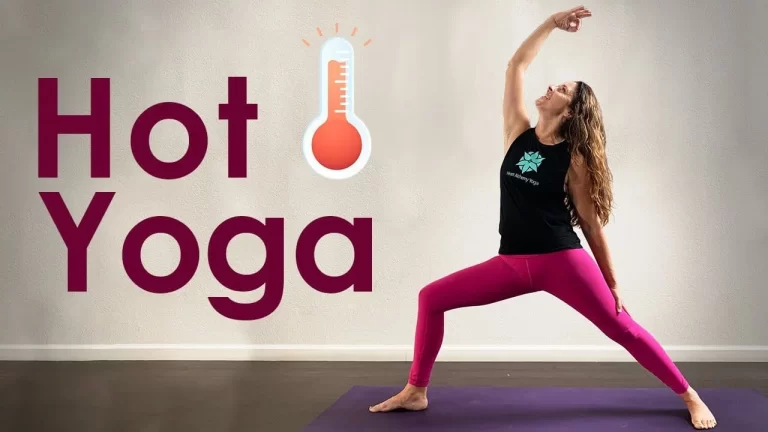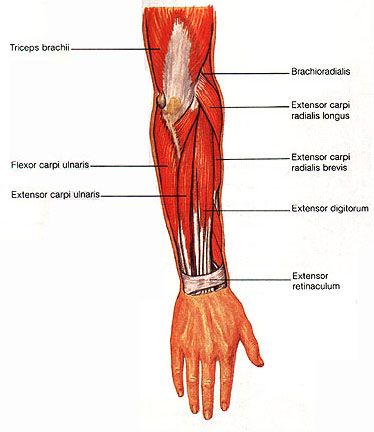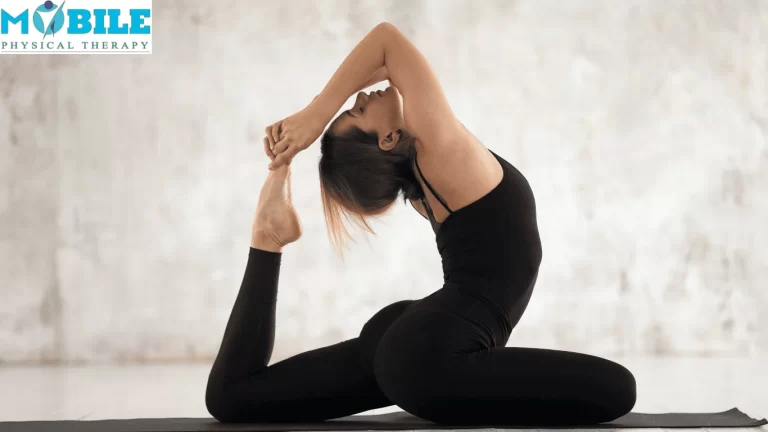Trapezius muscle exercise
Table of Contents
Introduction
- Trapezius muscle exercise helps to strengthen your trapezius muscles, It helps to improve your posture, It helps to Strengthen your upper back muscles, It helps to stabilize your neck. It helps to stabilize the upper back, It helps to decrease the strain on your neck and shoulder muscles, also help to decrease chronic neck pain
- The Trapezius initiate from the medial third of the superior nuchal line; external occipital protuberance, nuchal ligament, and the spinous processes of the C7 to T12 vertebrae. The trapezius muscles insert into the lateral third of the clavicle, acromion, and spine of the scapula. The nerve supply of the Trapezius muscles is the spinal root of the accessory nerve (CN XI) (motor) C3 and C4 Cervical nerves (pain and proprioception). the arterial supply of the Trapezius muscle is the Transverse cervical artery (cervicodorsal trunk). The function of the trapezius muscles is stabilization and movement of the scapula. The upper fibers of the trapezius muscles elevate and rotate the scapula upward and extend the cervical. The middle fibers of the trapezius muscles do adduction (retract) the scapula. The lower fibers of the trapezius muscles do depression and aid the upper fibers in upwardly rotating the scapula.
- Trapezius muscle exercise includes two types of exercise
- Strengthening exercise of the Trapezius muscles
- Stretching exercise of the Trapezius muscles
Health benefits by doing a trapezius muscle strengthening exercise.
- trapezius muscle strengthening exercise helps to improve the strength of your trapezius muscle
- It helps to improve range of motion of the neck
- It helps to boost your neck muscles
- It helps to strengthen your upper back muscles.
- It helps to improve your posture.
- It helps to Strengthen your trapezius muscles
- It helps to stabilize your neck
- It helps to stabilize the upper back
- It helps to decrease the strain on your neck and shoulder muscles
- It helps to decrease chronic neck pain
- It helps to move your scapula free.
- It also helps you to carry objects overhead.
Strengthening exercise
Shoulder blade squeeze
- How to do it?
- Unless you are a bodybuilder and trying to get a large trapezius, you need exercises to help the trapezius do its job well, stabilizing the shoulder and upper back.
- For the Shoulder blade squeeze exercise, you have to stand with good posture.
- Slowly squeeze your shoulder blades together and hold for 3 to 5 seconds.
- Then slowly release the shoulder blades back to their normal positions.
- This exercise you can also do this with the resistance band, using cables, or holding your arms out front in a goalpost position.
- do this 5 to 10 times.
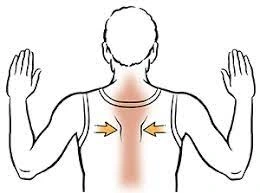
Shrug
- How to do it?
- Simple shrugs exercise is another exercise to keep your trapezius muscle strong. The shrug is very common and easy to implement, and it is one of the great exercises to activate your trapezius. For an added challenge, you can do this exercise with weights like dumbbells in your hands.
- For the Shrug exercise, you have to Stand straight with good posture.
- Raise your shoulder as high as you can get them towards your ears with your shoulders.
- Hold for a count of 2 to 4.
- Release them back into their starting positions.
- Repeat 20 to 30 times.
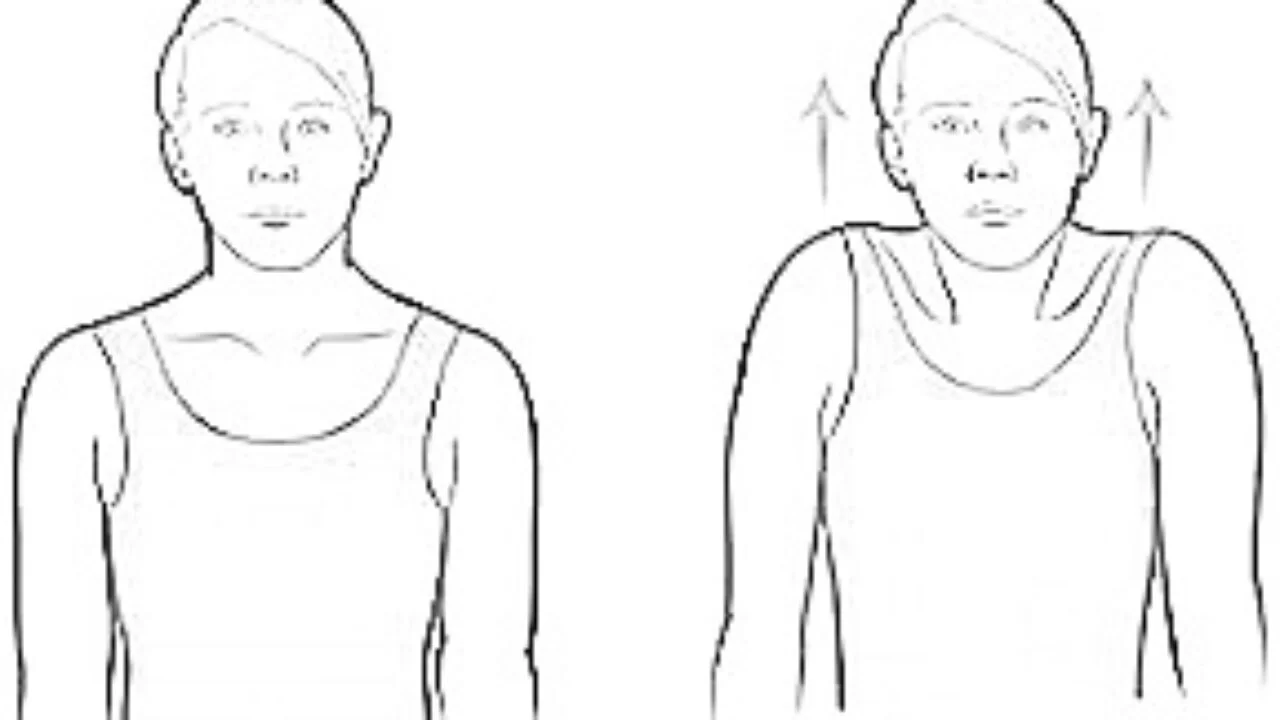
Upright row
- How to do it?
- This is a very known exercise to strengthen the trapezius muscle. You can also do this with a barbell or a dumbbell in your hands.
- For the Upright row exercise, you have to Stand straight.
- With your fists clenched, pull up your fists as high as you can while bending your elbows, your hands should be close to the front of your body.
- Hold for a count of 2 to 4.
- Release your arms back into a starting position, fists still clenched.
- Repeat 20 to 30 times.
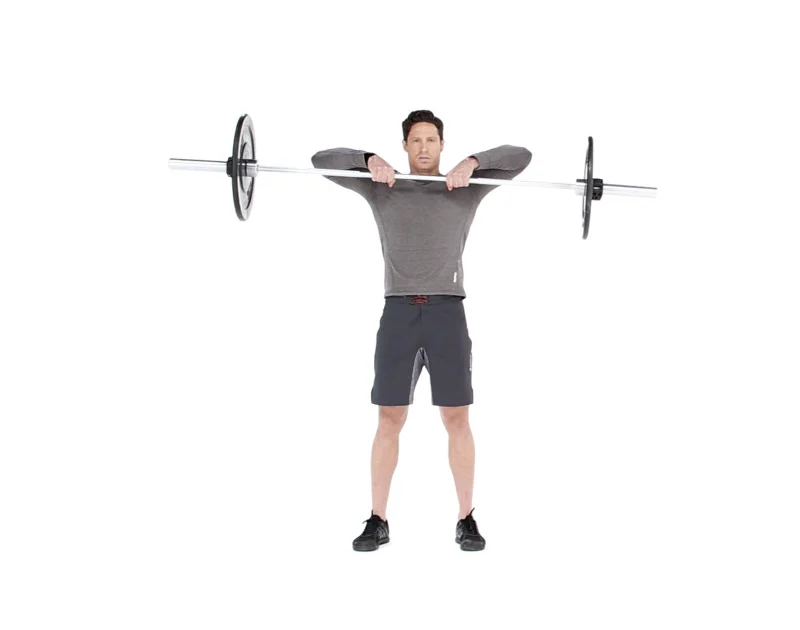
Pushup
- How to do it?
- There have so many different variations of the pushup. Do this version that is easy for you to do, A standard pushup, a pushup while kneeling on the floor, or a standing pushup against a wall. place your hands flat on the floor or the wall.
- Lower your body toward your hands while keeping your back straight and your tummy engaged.
- Do not let your head drop; your neck should be in line with the rest of your spine. Lower your body until you are close to the floor or the wall, and then push back into an upright position. Inhale as you go down and exhale as you push up.
- The key to the pushup exercise is to concentrate on pushing the shoulders together during the exercise.
- Make your middle trapezius and lower trapezius work to do their work.
- you can do 10 to 12 repetitions per workout.
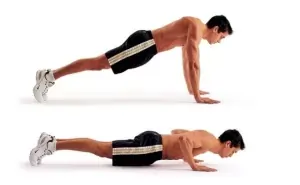
Farmer’s Carry
- How to do it?
- For the Farmer’s Carry exercise, you have to grab a weight (dumbbells or kettlebells will do) in both hands by your sides and stand straight.
- Then engage your core and back muscles, holding a strong, upright posture.
- Now walk forward holding a weight in your hands.
- You can do this for 25 to 35 seconds of 2 to 3 sets.

Cable Face Pull
- How to do it?
- Get your face in on the action with this underrated move of the trapezius.
- The Cable Face Pull exercise can be done with a cable machine or even with a resistance band if you are focused on mastering the form to help bulletproof your back and shoulders. The face pull hits your lower trapezius muscle when done right.
- For this exercise, you have to Set the cable machine or the resistance band roughly at your eye-level height.
- Hold the cable rope handles or the ends of the resistance band in both hands in an underhand grip. Then Squeeze your shoulder blades to pull toward your face, your elbows should be high, and resist the urge to lean forward.
- Pause to squeeze once you pull back as far as you could, then control the cable or resistance bands back to the initial position.
- You can do 10 to 15 repetitions for 2 to 3 sets.
Dumbbell Military Press
- How to do it?
- This classic exercise for standard shoulder builder—but you will nail your trapezius muscles, too. Working with the dumbbells allows you to work in more shoulder-safe positions, especially because you will be less inclined to try to lift more weight than you can handle by stacking plates on the barbell.
- Hold the pair of dumbbells in your hands and raise them to your shoulders.
- Brace your core and glutes to set a firm foundation—the biggest mistake you want to avoid is rounding your back under the weight. keep your ribs flaring. Once you are ready to press, make sure that you are not lifting straight up.
- You want to move in the scapular plane about some degrees in front of your trunk (to keep your rotator cuffs safe) so rotate your elbows out slightly.
- Then Contract your shoulder blades, then press the weight up.
- You can do 10 to 20 repetitions for 2 to 3 sets.
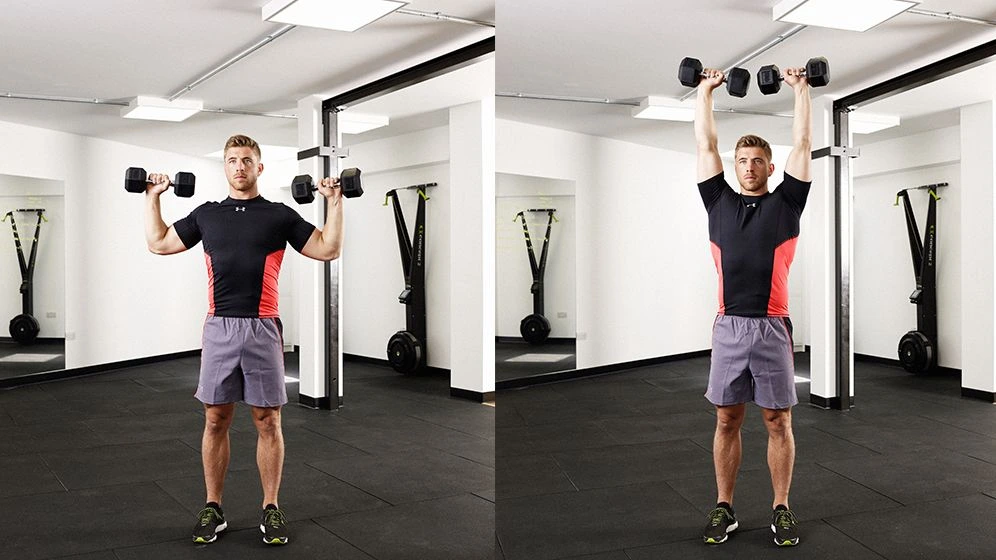
Dumbbell Snatch
- How to do it?
- You typically don’t think of explosive moves like snatches as back exercises, but posterior muscles like a trapezius are essential to proper form.
- You will get your whole body engaged to do the dumbbell snatch exercise right, especially as you get the dumbbell up above your head.
- Begin with the dumbbell on the ground in front of you between your legs with your feet wider than shoulder-width apart. Bend at the knees and hinge at the hips and You have to hold the dumbbell in an overhand grip.
- then Sit backward on your heels, then explode up to stand, and drive your weight up close to your body. Pull the weight up as if you are zipping a coat and then pull slightly back and land under the weight overhead. Lower the weight slowly to your shoulder to complete the move.
- You can do 10 to 15 repetitions for 2 to 4 sets.
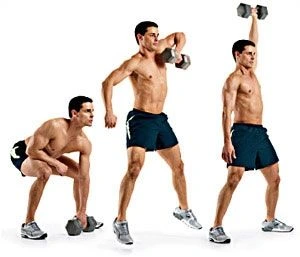
Bent Over Y
- How to do it?
- The Bent Over Y is a very simple exercise that can be used as a warmup.
- For the Bent Over Y exercise, you have to Stand with your feet shoulder-width apart and grab light dumbbells with your thumbs facing up.
- Then Hinge at the hip to assume a bent-over position. elevate your arms in front of you forming the shape of the Y letter, holding the position for a beat. Then slowly return to the beginner position.
- You can do 10 to 12 repetitions for 2 to 3 sets.
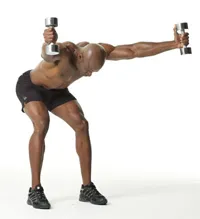
Pull up Shrug
- How to do it?
- This exercise not only builds your trapezius but also will also help you hone your pull-up form. You will also work your lattisimus dorsi, so you do not isolate one muscle.
- You have to hang from a pull-up bar, your spine should be aligned and your core muscles tight.
- Your shoulders should be pulled back and down to extend your head and neck upward. Hold for a two-count, then lower yourself back into the initial position.
- Do 12 to 15 repetitions for 2 to 3 sets.
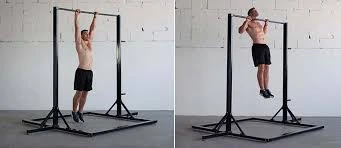
Barbell Shrug
- How to do it?
- The barbell shrug is the king of all trapezius muscle-strengthening exercises. It targets the upper head of your trapezius muscle, which is responsible for lifting your shoulder blades.
- Then hold a barbell with an overhand grip that is just beyond shoulder-width apart, and let the barbell hang at arm’s length in front of your waist. your back should be arched naturally, lean forward at your hip about 10 to 15 degrees.
- Flexed your knees slightly. then shrug your shoulders toward your ears as high as you could. Your arms should be extended. Pause, then reverse the movement back to the beginning position.
- you can do 10 to 15 repetitions for 2 to 3 sets.
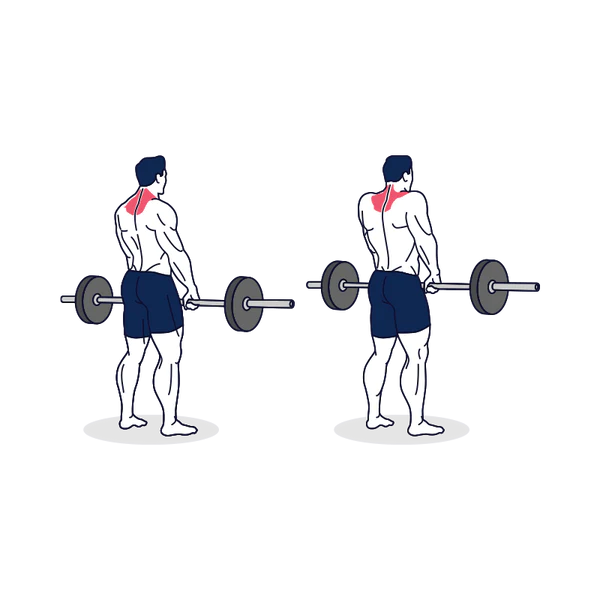
Rack Pull
- How to do it?
- For the Rack Pull exercise, you have to Set up a rack or boxes so the bar is elevated above your shins.
- then hold the barbell around shoulder-width with an overhand grip.
- Hinge from the waist and push your hips back and feet through the floor, pulling the barbell up and your back should be straight. Pause at that point for 2 to 3 seconds, then control the barbell back down into the starting place.
- You can do 10 to 18 repetitions for 2 to 3
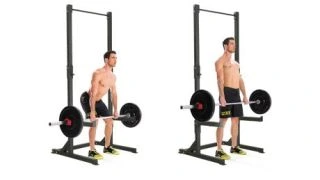
Dumbbell/Kettlebell Shrug
- How to do it?
- Compared to the barbell shrug, the dumbbell or kettlebell shrug put less stress on the shoulder joints.
- That is because your shoulder joints do not have to rotate to hold a barbell. This can keep them more stable as you do the movement.
- For the Dumbbell/Kettlebell Shrug exercise, you have to stand shoulder-feet width apart and hold a pair of dumbbells or Kettlebells in your hands.
- Let them hang at arm’s length by your sides, your palms facing each other. Shrug your shoulders towards your ear as high as possible for you.
- then Pause in the up position for 5 seconds, then slowly lower the weights back to the starting position.
- You can do 15 to 25 repetitions for 2 to 3 sets.
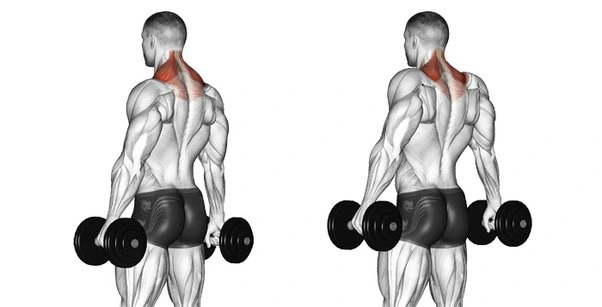
Incline Dumbbell Shrug
- How to do it?
- This variation of shrug target your lower trapezius muscles. the lower trapezius function is pulling your shoulder blades downwards.
- For the Incline Dumbbell Shrug exercise, you need a low-incline bench. hold a pair of dumbbells in both hands and lie chest down at 45 to 50 degrees on the bench.
- Your arms should be hanging straight down, with both palms facing toward each other. By pulling the shoulder blades together shrug your shoulders. Hold for 5 to 8 seconds then slowly lower it down to the beginning position.
- You can do 10 to 15 repetitions for 2 to 3 sets.

Dumbbell Jump Shrug
- How to do it?
- the explosive movement can add power to your daily workout. Your goal should be to do each and every repetition as quickly as possible while maintaining control of the weight at every time.
- Hold a pair of dumbbells in each hand and bend your hips and knees. Let the dumbbell hang at arm’s length just below the knees, your palms facing your sides. Do not round your low back.
- Simultaneously thrust your hips forward, then your shoulders forcefully, and jump as much as you can do. Land as softly as possible, and then repeat.
- You can do this for 10 to 15 repetitions.
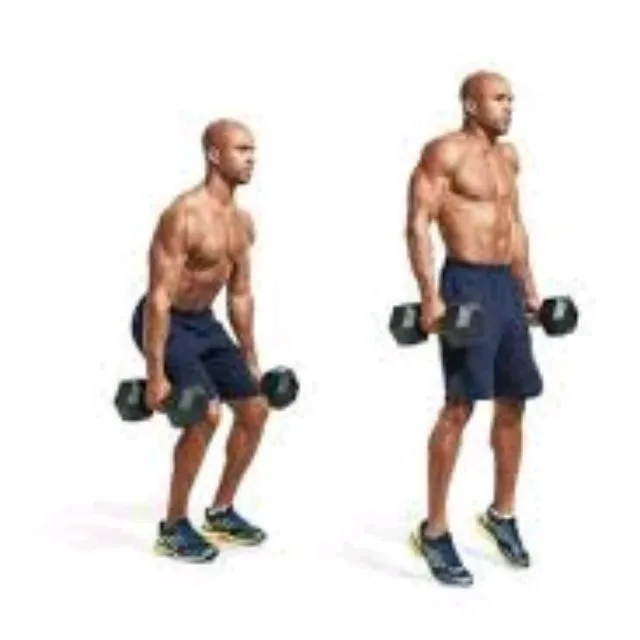
Barbell Behind-the-Back Shrug
- How to do it?
- This variation of shoulder shrug targets your upper trapezius muscle, middle trapezius, and levator scapulae—the rope-like muscle that runs down the back of your neck.
- While performing this exercise, do not stick your head forward or downward. This can increase your risk of injury and prevent your trapezius muscle from fully activating.
- This exercise is the same as a barbell shrug, except you are holding the barbell behind the body.
- You have to hold the barbell with an overhand grip so your palms are facing away from you, and your hands are shoulder-width apart.
- Let the barbell hang at arm’s length at your buttocks, and then shrug your shoulders toward your ears as much as you can. You can hold for 2 to 3 seconds, then reverse this same movement again.
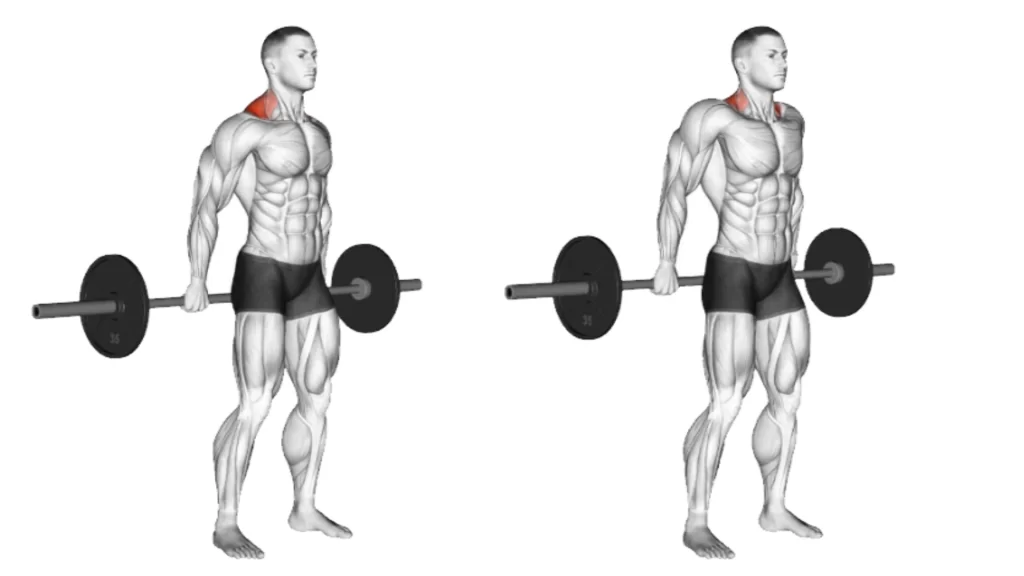
Barbell Row
- How to do it?
- Rowing exercises target your middle and lower trapezius and rhomboids, muscles that help keep your shoulder blades from moving as you lift the barbell.
- That is very important because unstable shoulders can limit your strength in exercises for your chest and your arms. Your upper trapezius, posterior deltoids, and rotator cuff muscles will also assist in a rowing movement.
- You have to hold the barbell with an overhand grip that is just beyond your shoulder width and hold it at arm’s length. bend your hips and knees and lower your trunk until it is almost parallel to the floor. your back should be naturally arched.
- Then pull the barbell to your upper abdominals and squeeze your shoulder blades toward each other. hold for 2 to 4 seconds, then slowly lower the barbell back to the beginning position.
- You can do 10 to 15 repetitions for 2 to 3 sets.
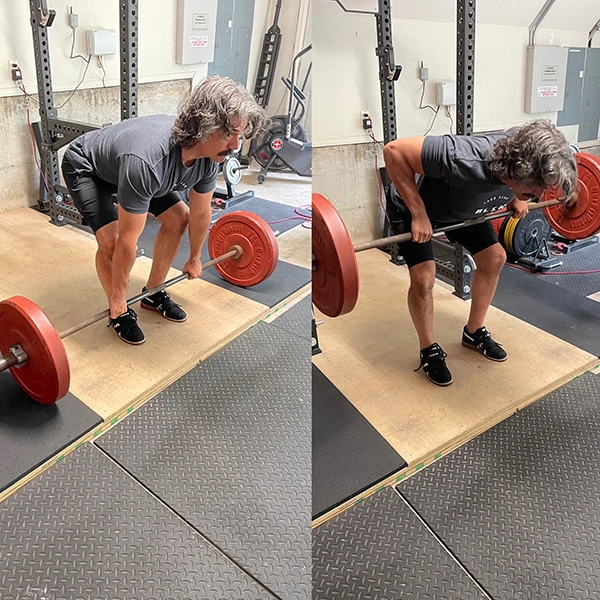
Dumbbell Lateral Raise
- How to do it?
- You have to hold a pair of dumbbells and let them hang by your side. Stand tall, with your feet- shoulder-width apart.
- Move your arms so that your palms are facing forward, and bend your elbows slightly.
- Without changing the bend in your elbows, elevate your arms to your sides and slightly in front of your trunk (in the scapular plane, remember) until they are at the level of the shoulder.
- As your arms get close to parallel with the ground think about turning your thumbs slightly upwards towards the ceiling.
- You are biasing your shoulders into external rotation by doing this, which is safer for the rotator cuff muscle.
- Your arms should form a T with your body. Pause for 2 seconds at the top of the movement, then slowly lower the dumbbell back to the beginning position.
- You can do 20 to 25 repetitions for 2 to 3 sets.

Overhead Barbell Shrug
- How to do it?
- Holding the barbell above your head as you shrug utilize your upper trapezius muscle. It also decreases the emphasis on your levator scapulae—the rope-like muscle that runs down the back of your neck and is frequently overused compared to the upper trapezius muscle.
- For the Overhead Barbell Shrug exercise, you have to stand shoulder-feet width apart and Load the barbell with a low weight.
- Grab the barbell with a wide overhand grip your arms should be extended and lock your elbows, then shrug your shoulders towards the ear.
- Hold at that movement for a couple of seconds then slowly back to the beginning position.
- You can do 6 to 10 repetitions for 2 to 3 sets.
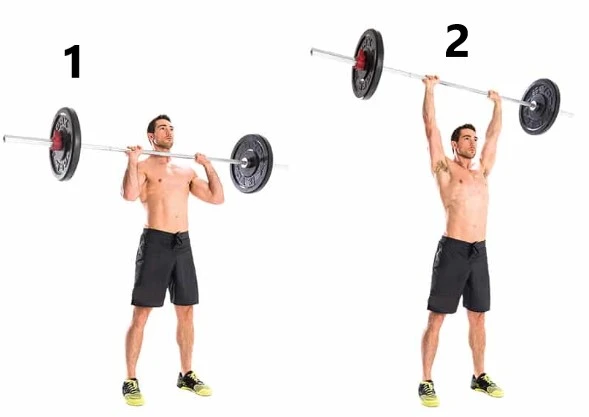
Snatch-Grip Barbell High Pull
- How to do it?
- The Snatch-Grip Barbell High Pull exercise, however, is a fast power movement that relies on the trapezius, mid-back, rhomboids, deltoids, hamstrings, and glutes, and lowers back to move the weight.
- For the Snatch-Grip Barbell High Pull exercise, you have to stand with shoulder-feet width apart and Load the barbell with a low weight.
- Grab the barbell with a wide overhand grip and let it hang at arm’s length in front of the body. Your hands should be some inches from the weight plates. Bent from your hips and knees to squat down. keep your lower back naturally arched.
- Pull the barbell as high as you can by explosively standing up as you bend your elbows and raise your upper arms. You should rise on your toes. Reverse the movement to return to the beginning position.
- You can do 12 to 16 repetitions for 2 to 3 sets.

Dumbbell Overhead Carry
- How to do it?
- If your lower body is moving, your upper body is also performing an isometric holding. This means you are increasing the trapezius time under tension, spurring muscle growth.
- For this exercise you have to stand with shoulder-feet width apart and hold a pair of dumbbells and press them over your head, keeping your palms facing toward each other.
- Your upper arms should be next to your ears, with holding dumbbells overhead you have to Walk forward.
- You can do 12 to 15 repetitions for 2 to 3 sets.
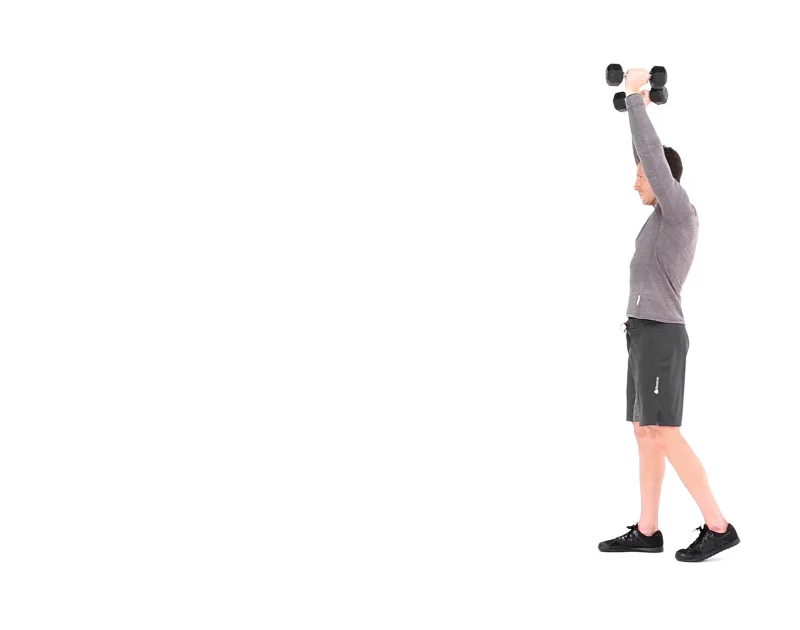
Scaption
- How to do it?
- While this exercise primarily hits your anterior deltoids, rotator cuff, and serratus anterior, your lower trapezius muscle and rhomboids also aid in lifting the weight.
- This exercise helps to balance the muscles which rotate your shoulder blades. Adding this exercise to your upper-body routine will also help build stronger, healthier shoulders and a good posture.
- For the Scaption exercise, you have Stand with your feet shoulder-width apart, and grab a pair of dumbbells at arm’s length next to your sides.
- Your palms should be facing toward each other and your elbows slightly bent Stand as tall as you can.
- Without changing the bend in your elbows, elevate your arms up to a 30-degree angle to your body (so that they form a Y) until they are at the level of the shoulder. The thumb sides of your both hands should be facing upward.
- Pause, then slowly lower the dumbbells back to the beginning position.
- You can do 8 to 15 repetitions for 2 to 3 sets.
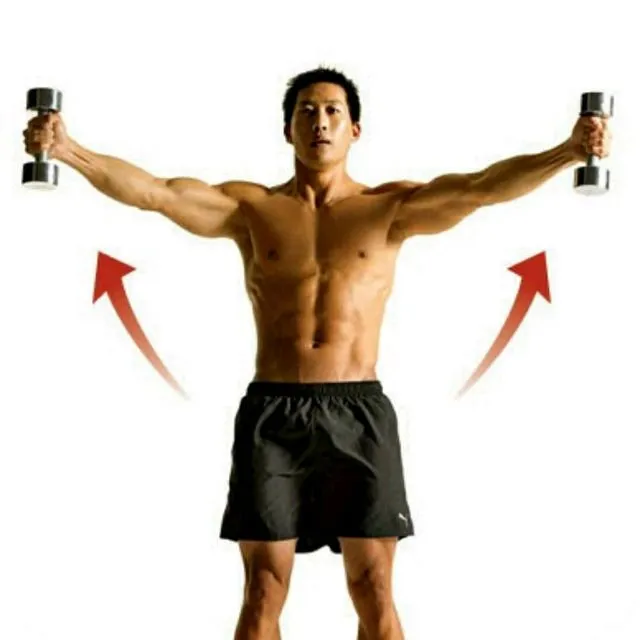
Stretching exercise
Shoulder Rolls
- Shoulder rolls are a great place to start with trapezius muscle stretches as they help get the muscle warmed up and loose before you start full-on stretches, making them more effective
- Shoulder rolls: a great warm-up with trapezius muscle stretches
- Sit or stand in a comfortable position with the good posture
- Roll both shoulders back and down and then forwards and up in the circular motion
- You can start with small circles and gradually make the circles bigger
- Spend 30 to 60 seconds doing this and then repeat in the opposite direction
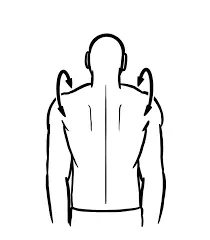
Chin Tucks
- Chin tucks or cervical retractions are an absolute must for anyone with neck or trapezius muscle pain. They help to realign the neck and ease the tension from the upper traps, combat a forward poking chin posture and loosen joints in the lower neck and the upper back.
- Chin Tuck Neck Retractions: Upper trapezius stretches
- The patient’s position is to Sit or stand upright in a good posture
- Slowly draw your chin inward towards your neck without tilting your head
- To ensure the technique is correct, imagine your chin is sitting on a shelf and you are sliding your chin in along the shelf – it should feel like you are giving yourself the double chin
- Hold for 3 seconds and then relax. Repeat 10 to 15
- Top Tips:
- a. Imagine a piece of string pulling up through the center of your head, drawing your head upwards throughout, and keeping the back of your neck long so you do not let the head tilt.
- b. It can really help to do chin tucks in front of the mirror when you start first. The movement often feels a little unnatural to start with and people often find themselves tilting their heads or drawing their shoulders back instead of just tucking in the chin.
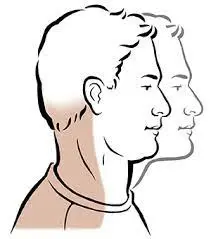
Upper Trap Side Bends
- Side bends are one of the best upper trapezius muscle stretches to start with for releasing chronically tight trapezius muscles. They can be modified to target different areas of the muscle and work well to relieve trapezius trigger points and knots. You want to start gently with these head tilts – do not be tempted to over-stretch too quickly else you might get some discomfort in your neck.
- Sit upright in the chair ensuring good posture
- Tilt your head to one side, taking your ear down towards the shoulder
- Keep your eyes and nose pointed forwards
- Hold for 3 seconds and return to the beginning position
- Repeat to the other side, aiming for 10 to 15 reps each way
- Progression: You can increase the stretch slightly further by placing your hand behind your back as shown before you start and keep it there throughout
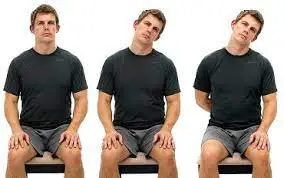
Upper Trap Head Tilts
- Head tilts are the next stage after side bends if you are looking for stronger stretches for the upper trapezius muscle. Again, take things slowly to start with so as not to increase any neck or trapezius pain.
- Sit upright in the chair, ensure good posture and hold the bottom of the chair with one hand
- Tilt your head to the opposite side, taking your ear towards the shoulder
- Anchoring your shoulder down by holding the bottom of the chair helps to increase the trapezius stretch
- Upper Trapezius Stretches: Head Tilts with progressions for the chronically tight trapezius
- Progressions:
- Place your free hand over the side of your head (towards the back) and gently pull your head further over for the stronger stretch
- Once your head is tilted over to the side, turn your head to look down towards your hip – you should feel the trapezius stretch further back
- Combine progressions 1 and 2 for an even stronger upper traps stretch
Top Tip: If you do not have a suitable chair that you can hold onto, sit on your hand to anchor the arm down

Middle Trapezius Stretch
- This is a great middle trapezius muscle stretch for stretching both sides at the same time and can again be modified to increase the further stretch as your muscles relax.
- Middle Trapezius Stretches: for tight trapezius and trigger points
- Sit or stand ensuring the good posture
- Place your hands and forearms together as shown in the image
- Draw your shoulders and shoulder blades forwards until you can feel the stretch along your upper back
- Hold for 15 to 30 seconds and repeat 3 to 5 times
- Middle Trapezius Stretch Progression: for the trapezius tightness and pain
- Progressions:
- Interlace your fingers and draw your hands forwards until you can feel a stretch across your upper back
- Increase the stretch further by bringing your chin down towards the chest
Top Tip: You can change which fibers you stretch for trapezius muscle by varying the angle of your arms/height of your hands
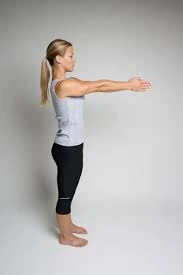
Sideways Child’s Pose
- This twist on the yoga child’s pose position is a lovely stretch for the trapezius muscle and the upper back.
- Sideways Child’s Pose: A very good stretch for the trapezius muscles
- Kneel on all fours, hands under shoulders, knees under your feet
- Slowly sit your buttocks back onto your feet, letting your chest come down to the ground
- Holding the position, gradually slide/walk your hands out to the side to stretch out your tight trapezius
- Hold for 30 seconds, then take your hands over to the other side and then repeat
- Return to starting position and then repeat 2 to 3 times each way
- Progression: You can increase the middle and lower trapezius muscle stretch by taking in a couple of deep breaths as you hold the stretch
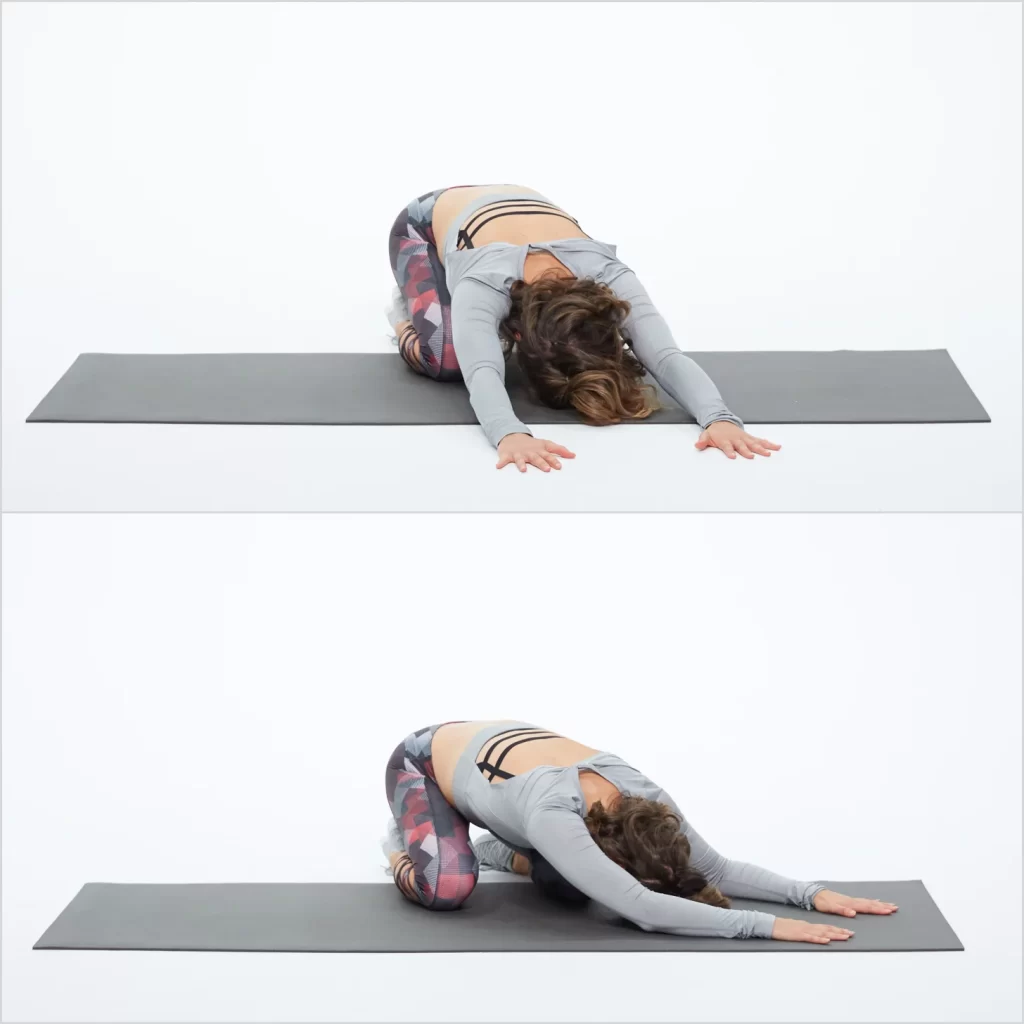
Massage Ball Stretches
- If you want to know how to stretch trapezius trigger points or knots, massage ball stretches are perfect. If you do not have a massage ball you can use a tennis ball, lacrosse/hockey ball, racquetball, or even a golf ball. There are loads of variations to stretch different parts of the trapezius muscle – we will start with the basics and work them from there.
- NB Do not roll over bony areas e.g. shoulder blades or spine – you should be rolling through the trapezius ms.
- Trapezius Stretches With Massage Ball: Perfect for chronically tight trapezius or trapezius trigger points
- Stand with your back towards the wall and place the ball behind your back over the trapezius muscle knot/tight area
- Lean back into the ball to apply gentle pressure to stretch the trapezius
- For a knotted trapezius muscle hold the pressure for 30 to 60 seconds, for a chronically tight trapezius roll the ball in small movements (up/down, side/side, or circles) for 1 to 2 minutes
- Progression: To stretch further through the trapezius muscle without moving your body, raise both arms, either out in front of you or out to the side – it gives a lovely dynamic stretch to the trapezius muscles
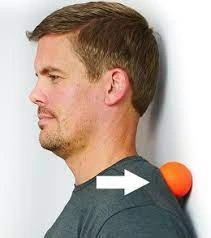
Upper Trapezius Stretches With Ball
- If you are looking to use the massage ball for upper trapezius muscle stretches, there are a few different ways you can do it:
- Upper Trapezius Stretches With Massage Ball: Perfect for trapezius muscle knot or super tight trapezius
- Upper Trapezius Stretch 1: The patient position is to Lie on your stomach, rest your head onto one hand and use the other hand to roll the ball around to gently massage the base of the skull and the side of the neck
- Upper Trapezius Stretch 2:The patient’s position is to Lie on the floor and place the ball underneath you at the back of the upper traps. Move the ball to the trapezius muscle knot, push gently into the ball and hold. Or for a more general super tight trapezius muscle stretch roll the ball around
- Upper Trapezius Stretch 3: If you have a super tight trapezius right at the top of your shoulder, lie on the ground in an open doorway so your head goes through the door and your shoulder is lined up with a wall. Place the ball between the wall and your upper trapezius muscle and scoot closer to the wall to apply pressure through the knotted or tight trapezius muscle.
- Upper Trapezius Stretch 4: The patient’s position is to Stand by an open doorway and bend at the waist so your shoulder is lined up with the wall. Place a ball on the top part of your trapezius muscle, between your neck and shoulder, lean into the ball and hold the upper trapezius muscle stretch.
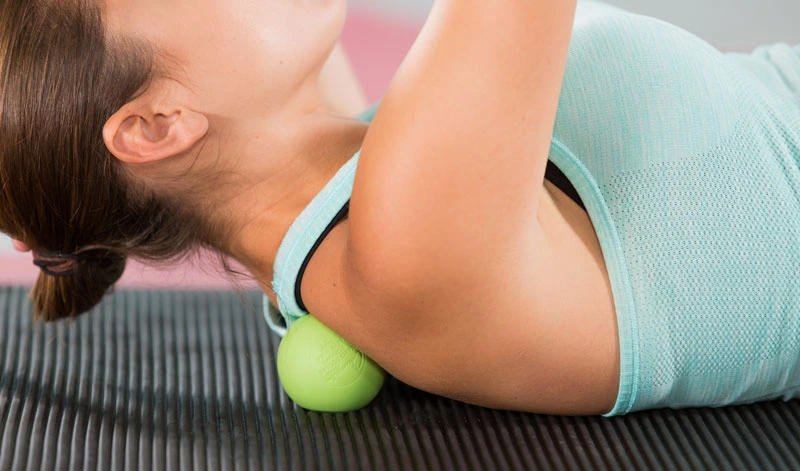
Middle Trapezius Stretch With Ball
- For the middle trapezius muscle stretches, move the ball down to the area you want to stretch between the shoulder blade and the spine (avoiding bone).
- Middle trapezius stretches with a massage ball
- You have to Place a ball between the wall and your middle trapezius muscle
- Lean into the ball and apply gentle pressure to the tight area of the muscle
- For the middle trapezius trigger point release, hold the pressure directly through the trapezius knot
- For a more general middle trapezius muscle stretch, bend and straighten your knees to roll the ball up and down through the muscle
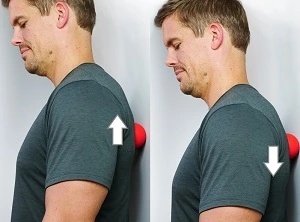
Lower Trapezius Stretch With Ball
- To do lower trapezius muscle stretches with the massage ball, simply move the ball down over the lower part of the rib cage.
- To do Lower Trapezius Stretches With a Ball, Stand with your back to the wall and place a ball between the wall and your lower traps
- Bend and straighten your knees to roll the ball up and down to stretch through the lower traps
- It is much less common to get lower traps to trigger points/knots than in the upper or middle traps, but if you do, hold the pressure through the ball over the trigger point rather than moving the ball.
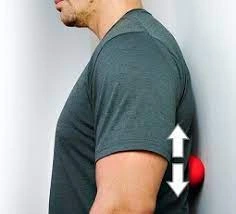
Hug stretch
- To do a hug stretch:
- The patient’s position is to Stand up straight.
- Reach the right arm across the chest and hold the left side shoulder. Do the opposite on the other side, holding the right shoulder with your left hand.
- Then Press down on your left shoulder with the right hand while leaning the head to the right.
- You can hold the stretch for about 20 seconds.
- Repeat on the other side.
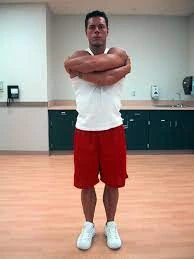
Safety and precautions
- Never perform trapezius workouts without learning the proper technique from an experienced trainer or physical therapist. This will help you to avoid injuries and soreness of muscles.
- Give your muscle to reasonable targets and never try to achieve so much fast. Start with slows and builds upon the sets and repetitions.
- Listen to your body. If you feel pain during exercise, stop doing immediately and consult your physical therapist or trainer.
- Start your trapezius workout fitness plan only after discussing it with your physical therapist. This is especially necessary for people who have some past health problems or are on some comorbidity.
- Always do trapezius stretching before and after your strengthening training. This will help you to improve your circulation and warms your muscles before the trapezius muscles workout.
- Even the best trapezius muscle exercises would not work if you do not use the equipment properly. This will prevents strains and injuries to the muscle.
When did you not do this exercise?
- If you are already suffering from neck and shoulder pain then avoid doing this exercise.
- If your healthcare provider is advised you of the rest.
- If you feel any neck or shoulder pain while this exercise then stops immediately.
- If you are suffering from pain in the back then avoid weight-lifting exercises.
- If your arm bone is recently fractured.
- If you recently feel any cervical-related problems.
Trapezius exercises at home
Shoulder blade squeeze
How to do it?
Unless you are a bodybuilder and trying to get a large trapezius, you need exercises to help the trapezius do its job well, stabilizing the shoulder and upper back.
For the Shoulder blade squeeze exercise, you have to stand with good posture.
Slowly squeeze your shoulder blades together and hold for 3 to 5 seconds.
Then slowly release the shoulder blades back to their normal positions.
This exercise you can also do this with the resistance band, using cables, or holding your arms out front in a goalpost position.
do this 5 to 10 times.
Shrug
How to do it?
Simple shrugs exercise is another exercise to keep your trapezius muscle strong. The shrug is very common and easy to implement, and it is one of the great exercises to activate your trapezius. For an added challenge, you can do this exercise with weights like dumbbells in your hands.
For the Shrug exercise, you have to Stand straight with good posture.
Raise your shoulder as high as you can get them towards your ears with your shoulders.
Hold for a count of 2 to 4.
Release them back into their starting positions.
Repeat 20 to 30 times.
Shoulder rolls
Shoulder rolls are a great place to start with trapezius muscle stretches as they help get the muscle warmed up and loose before you start full-on stretches, making them more effective
Shoulder rolls: a great warm-up with trapezius muscle stretches
Sit or stand in a comfortable position with the good posture
Roll both shoulders back and down and then forwards and up in the circular motion
You can start with small circles and gradually make the circles bigger
Spend 30 to 60 seconds doing this and then repeat in the opposite direction
Trapezius muscle exercises for pain
Shoulder blade squeeze
How to do it?
Unless you are a bodybuilder and trying to get a large trapezius, you need exercises to help the trapezius do its job well, stabilizing the shoulder and upper back.
For the Shoulder blade squeeze exercise, you have to stand with good posture.
Slowly squeeze your shoulder blades together and hold for 3 to 5 seconds.
Then slowly release the shoulder blades back to their normal positions.
This exercise you can also do this with the resistance band, using cables, or holding your arms out front in a goalpost position.
do this 5 to 10 times.
Shrug
How to do it?
Simple shrugs exercise is another exercise to keep your trapezius muscle strong. The shrug is very common and easy to implement, and it is one of the great exercises to activate your trapezius. For an added challenge, you can do this exercise with weights like dumbbells in your hands.
For the Shrug exercise, you have to Stand straight with good posture.
Raise your shoulder as high as you can get them towards your ears with your shoulders.
Hold for a count of 2 to 4.
Release them back into their starting positions.
Repeat 20 to 30 times.
Upper Trap Head Tilts
Head tilts are the next stage after side bends if you are looking for stronger stretches for the upper trapezius muscle. Again, take things slowly to start with so as not to increase any neck or trapezius pain.
Sit upright in the chair, ensure good posture and hold the bottom of the chair with one hand
Tilt your head to the opposite side, taking your ear towards the shoulder
Anchoring your shoulder down by holding the bottom of the chair helps to increase the trapezius stretch
Upper Trapezius Stretches: Head Tilts with progressions for the chronically tight trapezius
Progressions:
Place your free hand over the side of your head (towards the back) and gently pull your head further over for the stronger stretch
Once your head is tilted over to the side, turn your head to look down towards your hip – you should feel the trapezius stretch further back
Combine progressions 1 and 2 for an even stronger upper traps stretch
Top Tip: If you do not have a suitable chair that you can hold onto, sit on your hand to anchor the arm down
Upper trapezius exercises
Shrug
How to do it?
Simple shrugs exercise is another exercise to keep your trapezius muscle strong. The shrug is very common and easy to implement, and it is one of the great exercises to activate your trapezius. For an added challenge, you can do this exercise with weights like dumbbells in your hands.
For the Shrug exercise, you have to Stand straight with good posture.
Raise your shoulder as high as you can get them towards your ears with your shoulders.
Hold for a count of 2 to 4.
Release them back into their starting positions.
Repeat 20 to 30 times.
Upper Trap Head Tilts
Head tilts are the next stage after side bends if you are looking for stronger stretches for the upper trapezius muscle. Again, take things slowly to start with so as not to increase any neck or trapezius pain.
Sit upright in the chair, ensure good posture and hold the bottom of the chair with one hand
Tilt your head to the opposite side, taking your ear towards the shoulder
Anchoring your shoulder down by holding the bottom of the chair helps to increase the trapezius stretch
Upper Trapezius Stretches: Head Tilts with progressions for the chronically tight trapezius
Progressions:
Place your free hand over the side of your head (towards the back) and gently pull your head further over for the stronger stretch
Once your head is tilted over to the side, turn your head to look down towards your hip – you should feel the trapezius stretch further back
Combine progressions 1 and 2 for an even stronger upper traps stretch
Top Tip: If you do not have a suitable chair that you can hold onto, sit on your hand to anchor the arm down
Trapezius exercises for neck pain
Shoulder blade squeeze
How to do it?
Unless you are a bodybuilder and trying to get a large trapezius, you need exercises to help the trapezius do its job well, stabilizing the shoulder and upper back.
For the Shoulder blade squeeze exercise, you have to stand with good posture.
Slowly squeeze your shoulder blades together and hold for 3 to 5 seconds.
Then slowly release the shoulder blades back to their normal positions.
This exercise you can also do this with the resistance band, using cables, or holding your arms out front in a goalpost position.
do this 5 to 10 times.
Shrug
How to do it?
Simple shrugs exercise is another exercise to keep your trapezius muscle strong. The shrug is very common and easy to implement, and it is one of the great exercises to activate your trapezius. For an added challenge, you can do this exercise with weights like dumbbells in your hands.
For the Shrug exercise, you have to Stand straight with good posture.
Raise your shoulder as high as you can get them towards your ears with your shoulders.
Hold for a count of 2 to 4.
Release them back into their starting positions.
Repeat 20 to 30 times.
Upper Trap Head Tilts
Head tilts are the next stage after side bends if you are looking for stronger stretches for the upper trapezius muscle. Again, take things slowly to start with so as not to increase any neck or trapezius pain.
Sit upright in the chair, ensure good posture and hold the bottom of the chair with one hand
Tilt your head to the opposite side, taking your ear towards the shoulder
Anchoring your shoulder down by holding the bottom of the chair helps to increase the trapezius stretch
Upper Trapezius Stretches: Head Tilts with progressions for the chronically tight trapezius
Progressions:
Place your free hand over the side of your head (towards the back) and gently pull your head further over for the stronger stretch
Once your head is tilted over to the side, turn your head to look down towards your hip – you should feel the trapezius stretch further back
Combine progressions 1 and 2 for an even stronger upper traps stretch
Top Tip: If you do not have a suitable chair that you can hold onto, sit on your hand to anchor the arm down
Trapezius exercises with dumbbells
Farmer’s Carry
How to do it?
For the Farmer’s Carry exercise, you have to grab a weight (dumbbells or kettlebells will do) in both hands by your sides and stand straight.
Then engage your core and back muscles, holding a strong, upright posture.
Now walk forward holding a weight in your hands.
You can do this for 25 to 35 seconds of 2 to 3 sets.
Dumbbell Military Press
How to do it?
This classic exercise for standard shoulder builder—but you will nail your trapezius muscles, too. Working with the dumbbells allows you to work in more shoulder-safe positions, especially because you will be less inclined to try to lift more weight than you can handle by stacking plates on the barbell.
Hold the pair of dumbbells in your hands and raise them to your shoulders.
Brace your core and glutes to set a firm foundation—the biggest mistake you want to avoid is rounding your back under the weight. keep your ribs flaring. Once you are ready to press, make sure that you are not lifting straight up.
You want to move in the scapular plane about some degrees in front of your trunk (to keep your rotator cuffs safe) so rotate your elbows out slightly.
Then Contract your shoulder blades, then press the weight up.
You can do 10 to 20 repetitions for 2 to 3 sets.
Dumbbell/Kettlebell Shrug
How to do it?
Compared to the barbell shrug, the dumbbell or kettlebell shrug put less stress on the shoulder joints.
That is because your shoulder joints do not have to rotate to hold a barbell. This can keep them more stable as you do the movement.
For the Dumbbell/Kettlebell Shrug exercise, you have to stand shoulder-feet width apart and hold a pair of dumbbells or Kettlebells in your hands.
Let them hang at arm’s length by your sides, your palms facing each other. Shrug your shoulders towards your ear as high as possible for you.
then Pause in the up position for 5 seconds, then slowly lower the weights back to the starting position.
You can do 15 to 25 repetitions for 2 to 3 sets.
Lower trap exercises
Scaption
How to do it?
While this exercise primarily hits your anterior deltoids, rotator cuff, and serratus anterior, your lower trapezius muscle and rhomboids also aid in lifting the weight.
This exercise helps to balance the muscles which rotate your shoulder blades. Adding this exercise to your upper-body routine will also help build stronger, healthier shoulders and a good posture.
For the Scaption exercise, you have Stand with your feet shoulder-width apart, and grab a pair of dumbbells at arm’s length next to your sides.
Your palms should be facing toward each other and your elbows slightly bent Stand as tall as you can.
Without changing the bend in your elbows, elevate your arms up to a 30-degree angle to your body (so that they form a Y) until they are at the level of the shoulder. The thumb sides of your both hands should be facing upward.
Pause, then slowly lower the dumbbells back to the beginning position.
You can do 8 to 15 repetitions for 2 to 3 sets.
Incline Dumbbell Shrug
How to do it?
This variation of shrug target your lower trapezius muscles. the lower trapezius function is pulling your shoulder blades downwards.
For the Incline Dumbbell Shrug exercise, you need a low-incline bench. hold a pair of dumbbells in both hands and lie chest down at 45 to 50 degrees on the bench.
Your arms should be hanging straight down, with both palms facing toward each other. By pulling the shoulder blades together shrug your shoulders. Hold for 5 to 8 seconds then slowly lower it down to the beginning position.
You can do 10 to 15 repetitions for 2 to 3 sets.
FAQ
Shrug: Simple shrugs exercise is another exercise to keep your trapezius muscle strong. The shrug is very common and easy to implement, and it is one of the great exercises to activate your trapezius. For an added challenge, you can do this exercise with weights like dumbbells in your hands. For the Shrug exercise, you have to Stand straight with good posture. Raise your shoulder as high as you can get them towards your ears with your shoulders. Hold for a count of 2 to 4. Release them back into their starting positions. Repeat 20 to 30 times. The second exercise is Shoulder rolls are a great place to start with trapezius muscle stretches as they help get the muscle warmed up and loose before you start full-on stretches, making them more effective Shoulder rolls: a great warm-up with trapezius muscle stretches Sit or stand in a comfortable position with the good posture Roll both shoulders back and down and then forwards and up in the circular motion You can start with small circles and gradually make the circles bigger Spend 30 to 60 seconds doing this and then repeat in the opposite direction
Shrug: Simple shrugs exercise is another exercise to keep your trapezius muscle strong. The shrug is very common and easy to implement, and it is one of the great exercises to activate your trapezius. For an added challenge, you can do this exercise with weights like dumbbells in your hands. For the Shrug exercise, you have to Stand straight with good posture. Raise your shoulder as high as you can get them towards your ears with your shoulders. Hold for a count of 2 to 4. Release them back into their starting positions.
Repeat 20 to 30 times. The second exercise to train your trapezius is Dumbbell/Kettlebell Shrug Compared to the barbell shrug, the dumbbell or kettlebell shrug put less stress on the shoulder joints. That is because your shoulder joints do not have to rotate to hold a barbell. This can keep them more stable as you do the movement. For the Dumbbell/Kettlebell Shrug exercise, you have to stand shoulder-feet width apart and hold a pair of dumbbells or Kettlebells in your hands. Let them hang at arm’s length by your sides, your palms facing each other. Shrug your shoulders towards your ear as high as possible for you. then Pause in the up position for 5 seconds, then slowly lower the weights back to the starting position. You can do 15 to 25 repetitions for 2 to 3 sets.
Shrug: Simple shrugs exercise is another exercise to keep your trapezius muscle strong. The shrug is very common and easy to implement, and it is one of the great exercises to activate your trapezius. For an added challenge, you can do this exercise with weights like dumbbells in your hands. For the Shrug exercise, you have to Stand straight with good posture. Raise your shoulder as high as you can get them towards your ears with your shoulders. Hold for a count of 2 to 4. Release them back into their starting positions.
Repeat 20 to 30 times. The second exercise to make your trapezius stronger is Dumbbell Military Press. This classic exercise for standard shoulder builder—but you will nail your trapezius muscles, too. Working with the dumbbells allows you to work in more shoulder-safe positions, especially because you will be less inclined to try to lift more weight than you can handle by stacking plates on the barbell. Hold the pair of dumbbells in your hands and raise them to your shoulders. Brace your core and glutes to set a firm foundation—the biggest mistake you want to avoid is rounding your back under the weight. keep your ribs flaring. Once you are ready to press, make sure that you are not lifting straight up. You want to move in the scapular plane about some degrees in front of your trunk (to keep your rotator cuffs safe) so rotate your elbows out slightly. Then Contract your shoulder blades, then press the weight up. You can do 10 to 20 repetitions for 2 to 3 sets.
Shrug: Simple shrugs exercise is another exercise to keep your trapezius muscle strong. The shrug is very common and easy to implement, and it is one of the great exercises to activate your trapezius. For an added challenge, you can do this exercise with weights like dumbbells in your hands. For the Shrug exercise, you have to Stand straight with good posture. Raise your shoulder as high as you can get them towards your ears with your shoulders. Hold for a count of 2 to 4. Release them back into their starting positions.
Repeat 20 to 30 times. The second exercise to train your trapezius is Dumbbell/Kettlebell Shrug Compared to the barbell shrug, the dumbbell or kettlebell shrug put less stress on the shoulder joints. That is because your shoulder joints do not have to rotate to hold a barbell. This can keep them more stable as you do the movement. For the Dumbbell/Kettlebell Shrug exercise, you have to stand shoulder-feet width apart and hold a pair of dumbbells or Kettlebells in your hands. Let them hang at arm’s length by your sides, your palms facing each other. Shrug your shoulders towards your ear as high as possible for you. then Pause in the up position for 5 seconds, then slowly lower the weights back to the starting position. You can do 15 to 25 repetitions for 2 to 3 sets.
To prevent your trapezius muscle from tightening, and to release tension from the trapezius muscle, you can do shoulder shrugs regularly throughout the day. Simple shrugs exercise is another exercise to keep your trapezius muscle strong. The shrug is very common and easy to implement, and it is one of the great exercises to activate your trapezius. For an added challenge, you can do this exercise with weights like dumbbells in your hands. For the Shrug exercise, you have to Stand straight with good posture. Raise your shoulder as high as you can get them towards your ears with your shoulders. Hold for a count of 2 to 4. Release them back into their starting positions.
Repeat 20 to 30 times.


